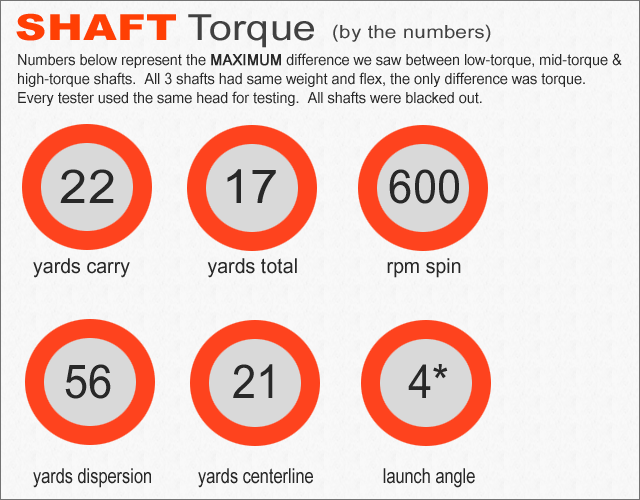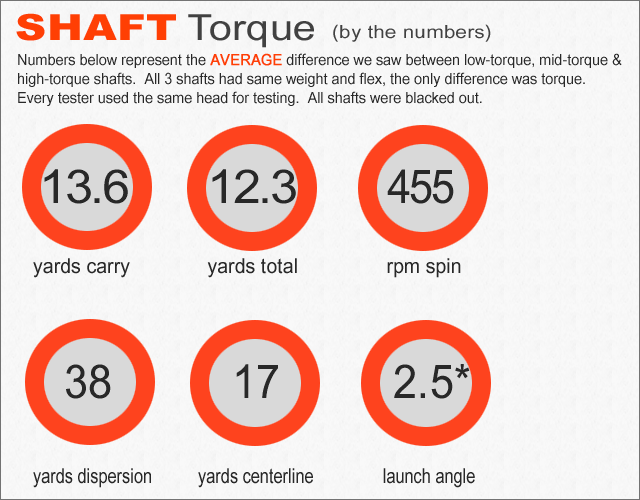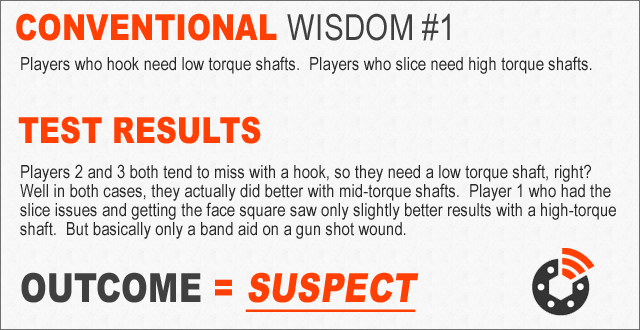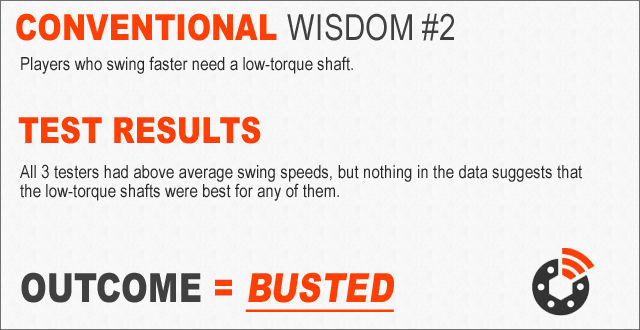(Written By: Matt Saternus) In two recent MyGolfSpy Labs, we’ve talked about the impact of shaft flex and shaft weight. The data we gathered showing the importance of fitting for the right flex and weight was shocking: we saw testers gain or lose 20 yards or more with the wrong flex or weight. Today, we discuss torque, which may be the least understood, and possibly most important variable in making your drives long and straight.
“What the hell is torque?”
Some of you know what torque is, some of you have seen the word on shaft spec sheets, but the majority of you are probably encountering it for the first time. Torque is really pretty simple: it’s the shaft’s resistance to twisting. Torque is measured in degrees (meaning: how many degrees will the shaft twist under a certain amount of force), and you’ll typically see measurements as low as 2° and as high as 5°, 6°, or 7°.
As with many other things, these numbers don’t necessarily mean a lot because there’s not a standard way to measure, but I’ve already done that rant.
“So…why should I care?”
You should care because torque is a major component in how a shaft feels, much more than flex. You could have an XX-stiff shaft with high torque, and it might feel “smooth” or even “whippy.” Alternately, you could have a senior flex shaft with low torque that can feel “boardy.”
Torque also has a major impact on where the ball ends up. All other things being equal, a shaft with higher torque will lead to a club face that is pointed further left (for a RH golfer) at impact…but we know “all other things” are rarely equal when you add in the human element.
The Conventional Wisdom
The conventional wisdom on torque consists of two major tenets:
1) Players who tend to hook the ball will benefit from a lower torque shaft. Players who tend to slice the ball will benefit from a higher torque shaft.
2) Players who swing faster need lower torque. This assumption is built right into most shafts by the manufacturers: take virtually any shaft on the market, and the X-flex version will have lower torque than the S-flex, which has lower torque than the R-flex.
As always, we look at conventional wisdom like an email from a Nigerian prince who wants to transfer his wealth to us…that is to say, skeptically. So we put it to the test!
HOW WE TESTED
For this test, we had golfers test drivers with low ↓, mid ↔, and high torque ↑ shafts. All 3 shafts had the same weight and flex, the only difference was torque. The golfers were able to choose whether they wanted stiff or regular flex. Every player used the exact same head: a 10.5* Callaway RAZR Fit. To keep the testers from knowing what shaft they were testing, UST Mamiya supplied blacked out shafts with no distinguishing marks (I marked the grips so that I would know which shaft was which).
Each golfer hit 10 shots with each shaft and the results were measured by our FlightScope X2 launch monitor. All testing was done at the range at The Bridges of Poplar Creek Country Club.
What Effect Can Torque Have?
Validation
The numbers are indisputable: torque made a huge difference for our testers. To validate our results, I ran our numbers past the guys at UST Mamiya to see how our test compared to theirs. Once again, we saw the same things in our test that they did when they tested hundreds of golfers: no simple pattern, but a clear statement about the importance of fitting the golfer into the right shaft.
How Did Conventional Wisdom Hold Up?
Over the course of our last three labs, conventional wisdom has fared about as well as you would in a bar fight with Mike Tyson.
Why is Conventional Wisdom So Wrong?
Because golf clubs are swung by HUMAN BEINGS. If golf was played by robots (and I know many of our robot-loving readers wish it was), conventional wisdom would be great. Robots have no feel and they swing every club the exact same way. Our testers, on the other hand, do have feel.
Tester 3 hates boardy feeling shafts, so, despite the fact that his most-hated miss is a hook, he does not like low torque shafts. On the other hand, Tester 1 doesn’t like loose feeling shafts despite the fact that he needs all the help he can get to square the club face. Historically, he has found better success with lower torque shafts because he feels like he can release the club more aggressively.
The Takeaway
Torque matters, and, like flex and weight, there are no easy rules to follow. You need to try a variety of things and be fit into the shaft that will work best for you.
The other thing that we were able to see in this test is that feel is important. In past tests, players could not always feel the changes in the equipment, but in this test, they picked up on the differences right away. This allowed them to verbalize how the feel of the equipment impacted their swing. Though we do consider ourselves a data-driven site, and many would eschew feel as nebulous, the data seems to indicate that feel has a very real impact when it comes to a good fit.





















Morris
5 years ago
Excellent article! I went to a custom fitting session and after few hours of testing different woods shafts the conclusion was that I need (for a smooth feel) lighter shaft with high torque. The only problem was the prices for the new shafts, more than a new set of clubs. I asked them if they can recommend me something similar at a cheapest price and they say NO!!! I tried to find myself on the internet different brands with same characteristics but a little bit cheaper and after I’ve change it, surprise: it don’t works!!! In a mean time I’ve change my swing, increasing even the swing speed and I’m feel much more attracted by a stiffer shaft (even extra stiff and counterbalanced) with a low torque cause I want to know where is the club head through all the swing and I still have an inconsistent ball flight alternating hook with fade and straight. So, what type of shafts what would you recommend me for my woods? Now I use stiff shaft with 60 grams and 3.7 torque in driver, stiff shaft with 67 grams and 4.5 torque in 3 wood and also stiff shaft with 75 grams and 5 torque in hybrid. Thanks!